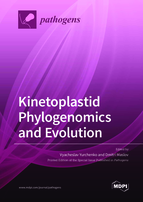Kinetoplastid Phylogenomics and Evolution
A special issue of Pathogens (ISSN 2076-0817).
Deadline for manuscript submissions: closed (31 October 2020) | Viewed by 30943
Special Issue Editors
Interests: parasitology; trypanosomatid biology; evolution; viruses
Special Issues, Collections and Topics in MDPI journals
Special Issue Information
Dear Colleagues,
A group of protists from the class Kinetoplastea showed a broad spectrum of life styles varying from free-living to obligatory parasitic. A transition to parasitism occurred independently several times within this group, with some lineages having evolved to become highly pathogenic. Both free-living and parasitic kinetoplastids are diverse, wide-spread, and ecologically important, testifying to the evolutionary success of this entire group. At least to some degree, this success was made possible by the evolution of peculiar features such as the kinetoplastids' modes of genome organization and expression, their highly adaptive metabolism (including mitochondrial up- and downregulation), the role played by endosymbionts, and their diverse and intricate adaptations to various host environments, just to name a few factors. A robust phylogenetic framework is a necessary pre-requisite for obtaining a better understanding of the evolutionary origins and significance of these traits. Unlike single gene-based phylogenies, those derived from phylogenomic approaches are more likely to serve as a solid foundation for evolutionary analyses. As illustrated by the articles presented in this volume, the goal of reconstructing a comprehensive phylogeny of kinetoplastids and using it to advance our understanding of the group's evolution is within reach.
Prof. Vyacheslav Yurchenko
Prof. Dmitri Maslov
Guest Editors
Manuscript Submission Information
Manuscripts should be submitted online at www.mdpi.com by registering and logging in to this website. Once you are registered, click here to go to the submission form. Manuscripts can be submitted until the deadline. All submissions that pass pre-check are peer-reviewed. Accepted papers will be published continuously in the journal (as soon as accepted) and will be listed together on the special issue website. Research articles, review articles as well as short communications are invited. For planned papers, a title and short abstract (about 100 words) can be sent to the Editorial Office for announcement on this website.
Submitted manuscripts should not have been published previously, nor be under consideration for publication elsewhere (except conference proceedings papers). All manuscripts are thoroughly refereed through a single-blind peer-review process. A guide for authors and other relevant information for submission of manuscripts is available on the Instructions for Authors page. Pathogens is an international peer-reviewed open access monthly journal published by MDPI.
Please visit the Instructions for Authors page before submitting a manuscript. The Article Processing Charge (APC) for publication in this open access journal is 2700 CHF (Swiss Francs). Submitted papers should be well formatted and use good English. Authors may use MDPI's English editing service prior to publication or during author revisions.
Keywords
- kinetoplastid
- trypanosomatid
- bodonid
- phylogeny
- phylogenomics
- parasitism
- endosymbiosis
- host–parasite relationships








